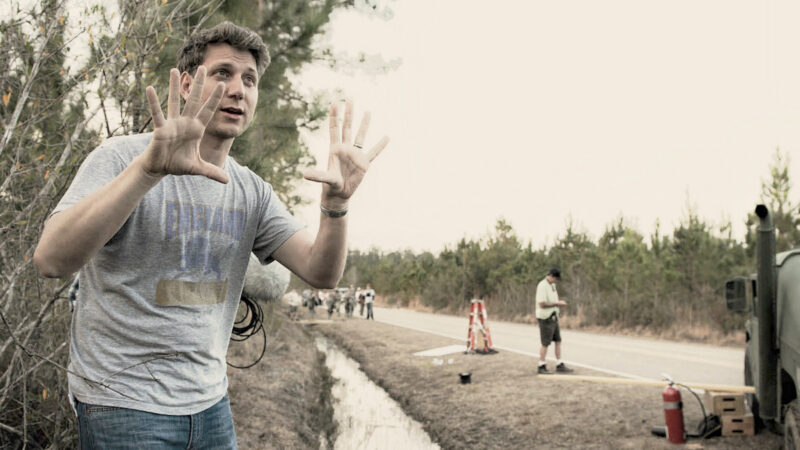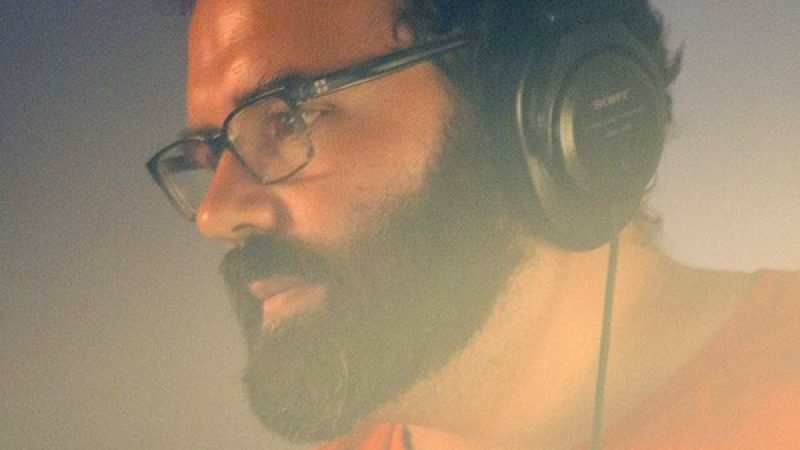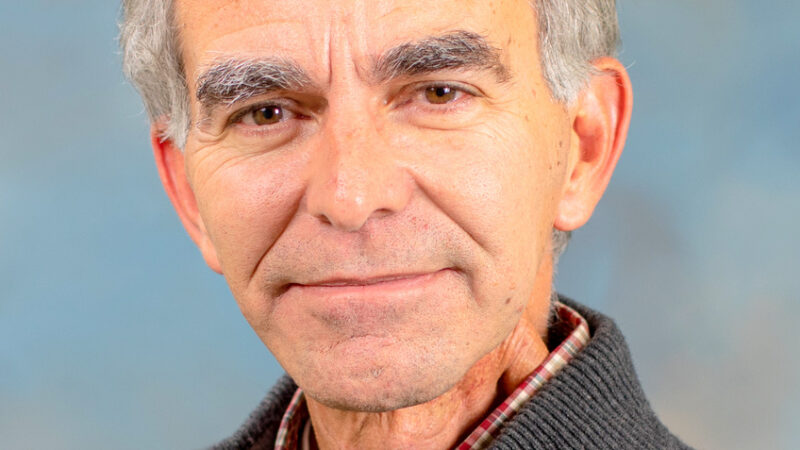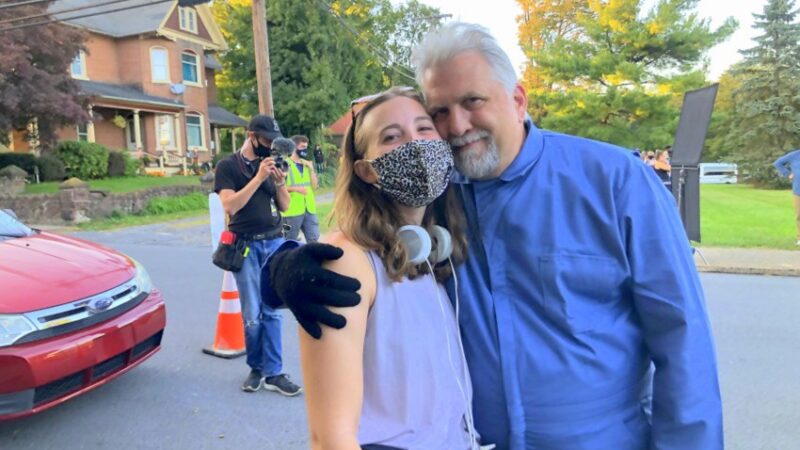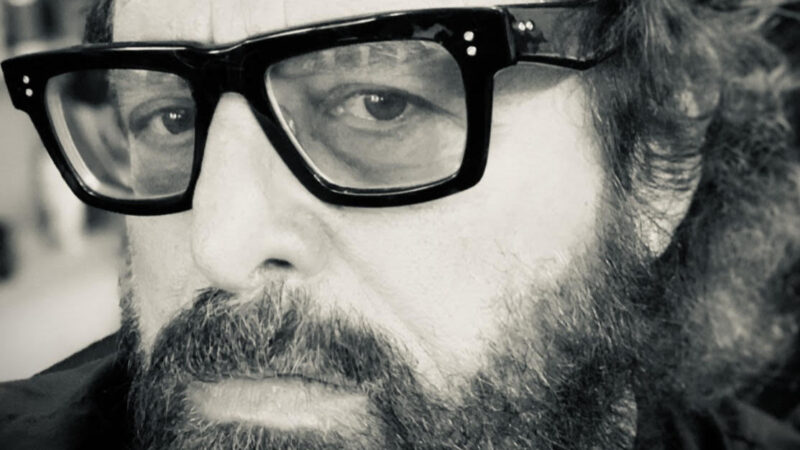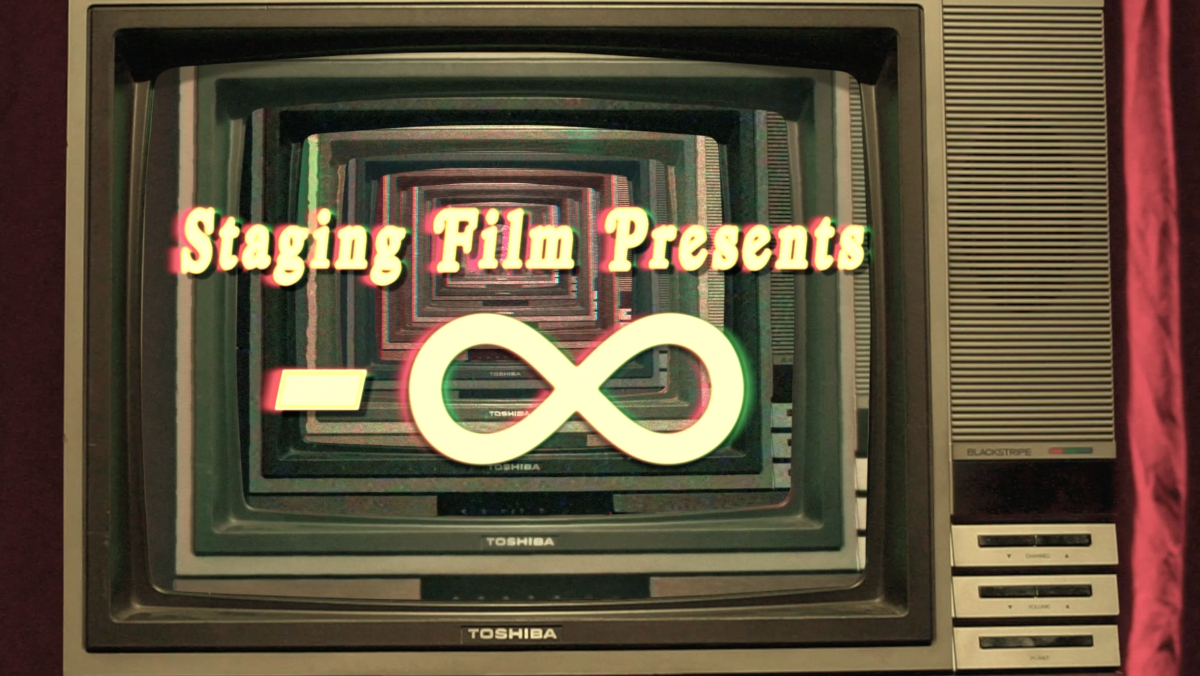
My name is Jocelyn Kuritsky, one of the producers for the short, The Bad Infinity. Set during a debauched dinner party in the twilight of late capitalism, four characters trapped in a 1980s sitcom reflect on the many ways in which modernity is seduced by “the bad infinity.” The cast includes Ben Beckley, Eliza Bent, Grace McLean, Jacqueline Reed, Greig Sargeant, Jake Hart, Jan Leslie Harding, Lynn Cohen, Lynne Marie Rosenberg, Steve Mellor, Tony Torn, and, and me, Jocelyn Kuritsky. The crew includes Graham Sack, Alex Basco Koch, Katja Andreiev, Nic Benacerraf, Isabella Limeri, among others.
indieactivity: What is your experience working on the story, the screenplay, the production, the premiere, and the marketing?
Jocelyn Kuritsky (JK): My focus tends to be – principally – the artists and the art, and I tend to worry about how we’re going to get it all out into the world later, which is, of course, good and bad. I met Graham Sack (writer/director) at a party a few years ago, toward the end of 2018. We spoke for a bit and exchanged numbers. I instinctually felt he might be the right person to helm a short film of one of the myriad of avant-garde artists I had been thinking should be translated to film with my initiative, Staging Film. Alex Basco Koch (producer) and I had been coffee-shop talking for several years about getting more American experimental theater onto film, particularly from our pseudo contemporary gurus, like Erik Ehn, Maria Irene Fornés, Mac Wellman. When I met Graham, who has an amalgam background in science, economics, virtual reality, and theater, I thought hmm. I approached Graham about it, and he expressed a lot of interest.
Then, at a meeting a few months later, in spring 2019, Meghan Finn (producer), Alex, Graham, and I discussed various possibilities and settled on probably adapting some of Mac Wellman’s work. Meghan suggested a bunch of texts for Graham to consider, and Graham took a deep dive. Then, by late summer, we had Mac’s blessing, thanks to his generosity and the fact that Meghan and I both have an artistic history with him. And, by early fall a screenplay was ready to go, and we started devising production on a shoestring budget. Production was fast and furious. Some of our support came directly from Meghan’s company, The Tank, and then I solicited individual donors, and the whole team begged and borrowed like crazy. We got a lot done in a short amount of time with a lot of last-minute goodwill on deck.
The Official Trailer for Bad Infinity produced by Jocelyn Kuritsky
I feel like we’re still in the midst of premiering and marketing, but my experience is what it often always is – promoting a project I believe in, taking advantage of as many opportunities as possible, valuing word of mouth, never underestimating the curiosity and interest of my community, and setting up screenings and various ways for my community to see the film. I am also just a big believer in being as open as possible; you never really know who or what may take a shine to you and your work. One set of eyes and ears can change the ascent of a project, and sometimes that set is surprising. I work hard to remember that
How did you put the crew and cast together? Did you start with a known cast?
Jocelyn Kuritsky (JK): I oversaw assembling the entire team, with lots of input from collaborators, particularly Graham Sack and Alex Basco Koch.
The crew came together fairly organically. Alex Koch was already slated as the cinematographer. H has a great eye, and he can simultaneously make things feel cinematic and theatrical. Alex and I bo knew Nic Benacerraf, and the expanse of his incredible skill set, and we asked him to join us as the production designer (and he later joined us as a producer as well). Graham knew Katja Andreiev, and Katja jumped in to design the costumes – highly resourceful and imaginative. Graham also knew Luke Allen, who became our attentive and methodical sound designer. Ani Taj, another Graham connection, came in one day to help with choreography and did a bang-up job in just a few short hours. Jeanette Oi-Suk Yew, Alex DeNevers, and Anthony Dean all contributed to our lighting design. Alex Basco Koch and I both knew Jeanette pretty well (a brilliant lighting designer in the NY community).
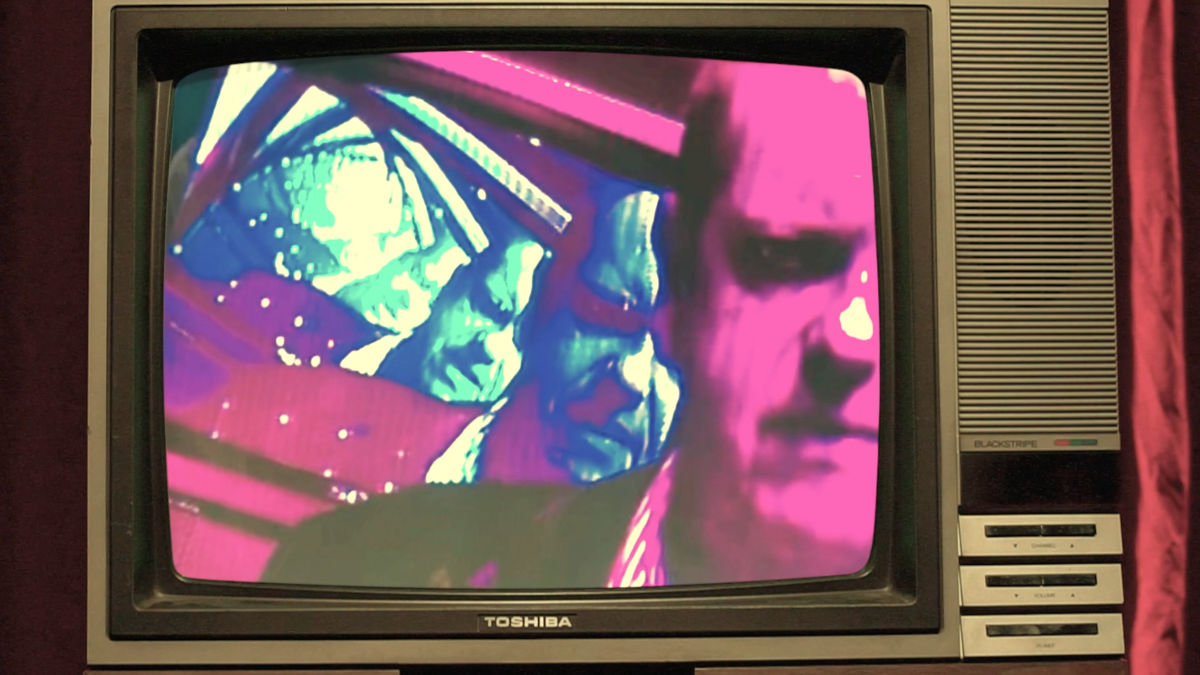
Jeanette then also brought on Alex DeNevers, who was wonderful. And Anthony Dean did some quick and great last-minute work with us as we were doing some of the final shooting. Our editors (Jessie Stead and Jules David Bartkowski) and our VFX artists (Mark Reynolds and Jim Yeo) came through Graham Sack and Alex Basco Koch and Alex’s production company, Ghost Corporeal. One of the inspired finds was our makeup artist, Isabella Limeri. She was recommended by my friend Emily Perkins (formerly of The Assembly). Emily and I spoke one day, and she was like, “Listen, this kid is amazing, call her.” So I did, and Emily was right. Isabella, who had limited professional experience at that point, jumped in headfirst, and completely astounded all of us. Lastly, the unsung heroes of the film, of course, are Jenn Allen, Ciji Singletary, and Dan Froot, who were miraculous assistants.
Casting was probably easier for me than putting the crew together. I know actors because I am an actor. Graham and I considered various wonderful performers, and we eventually settled on a color that was steeped in avant-garde theater and knew Mac’s work well. Actors like Jan Leslie Harding and Steve Mellor are Mac staples. Tony Torn and Greig Sargeant are both acclaimed, veteran downtown theater artists. I know many of the actors personally and have longstanding relationships with them, so, ya know, they took my call;). Grace McLean, Ben Beckley, Eliza Bent, Lynne Marie Rosenberg are also all fantastic performers, and I’ve known all of them for years. I did not know Jake Hart, but Graham did, and now I do! As far as I know, this film was actually the last film Lynn Cohen made. I had known Lynn, in earnest, since 2014 or 2015. We auditioned her for one role then asked her to play a different role, and hers became a kind of delicious cameo appearance. I am so grateful she came to hang out with us for a day in November of 2019. We have a ton of footage of her from that day. It was the last time I saw her in person.
What and how long did it take to complete the script? (Was it a team effort or was it solo?)
Jocelyn Kuritsky (JK): The script was adapted and assembled fairly rapidly, over the course of a few months. It was a team effort in the sense that Meghan Finn, Alex Basco Koch, Graham Sack, and I all contributed to deciding what text/artist we were going to work with and weighed in at various points. That said, the credit goes to Graham Sack, who directed the piece and wounding up adapting and fusing text from Mac Wellman’s The Bad Infinity (1983), Hypatia, or The Divine Algebra (2005), and Speculations (2008).
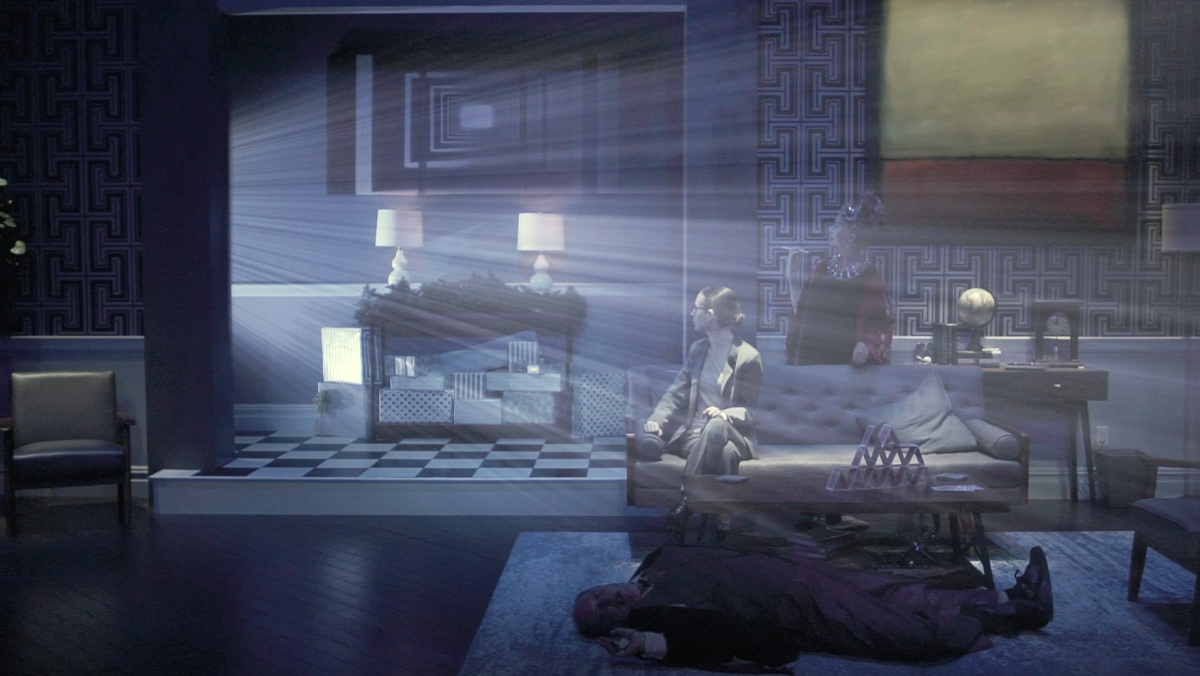
When did you form your production company – and what was the original motivation for its formation?
Jocelyn Kuritsky (JK): So, this project was produced with an initiative I started a few years ago, called Staging Film. Alex Basco Koch came aboard just as I was formulating it. And Meghan Finn has worked to support it since we started pushing the boulder up the hill. We are now partnered with Meghan’s company, the New YoYork-based theater, The Tank. The goal with Staging Film is really to explore ways to tell theater stories with film. We meld the contemporary stage and screen to create short translations rather than adaptations. This means experimenting with untraditional techniques in cinematography, set design, sound design, and performance to record the visceral magic of theater on camera. This really is the point – to explore the intersection of the screen and the stage, particularly with pieces that might not be super obvious cinematic candidates. And, we’ve even spoken about ways to keep the exchange flowing and fluid: stage to screen, but also screen-to-stage. What might it mean to put a piece of theater on film and then put it back on stage again?
When I started this initiative, I had work like Vanya on 42nd Street (with both Larry Pine and Lynn Cohen who have now worked with Staging Film), the American Film Theatre, and Shelley Duvall’s Faerie Tale Theatre in mind. I wanted to help create an appetite for a range of work I had seen or been e posed to that might not be known much beyond New York, or even beyond downtown New York. I thought new media could play a role, and I was very interested in the short form format. I thought of these films as teasers for a potentially larger discussion about expanding the theatrical audience and the ways in which we experience theater nationally, not knowing a pandemic in 2020 might really, collectively, make us rethink the theater and film divide. I think I started to kick Staging Film into g ar around 2015, and then with a little more oomph in 2016. We’ve produced about 7 short films.
What was the first project out of the gate?
Jocelyn Kuritsky (JK): Good question. I think it was Caridad Svich’s piece, This Thing of Ours, directed by José Zayas. I got Black-EyedSusan (the Ridiculous Theatrical Company) to join us, and José on-boarded Stephin Merritt (The Magnetic Fields), who scored it.
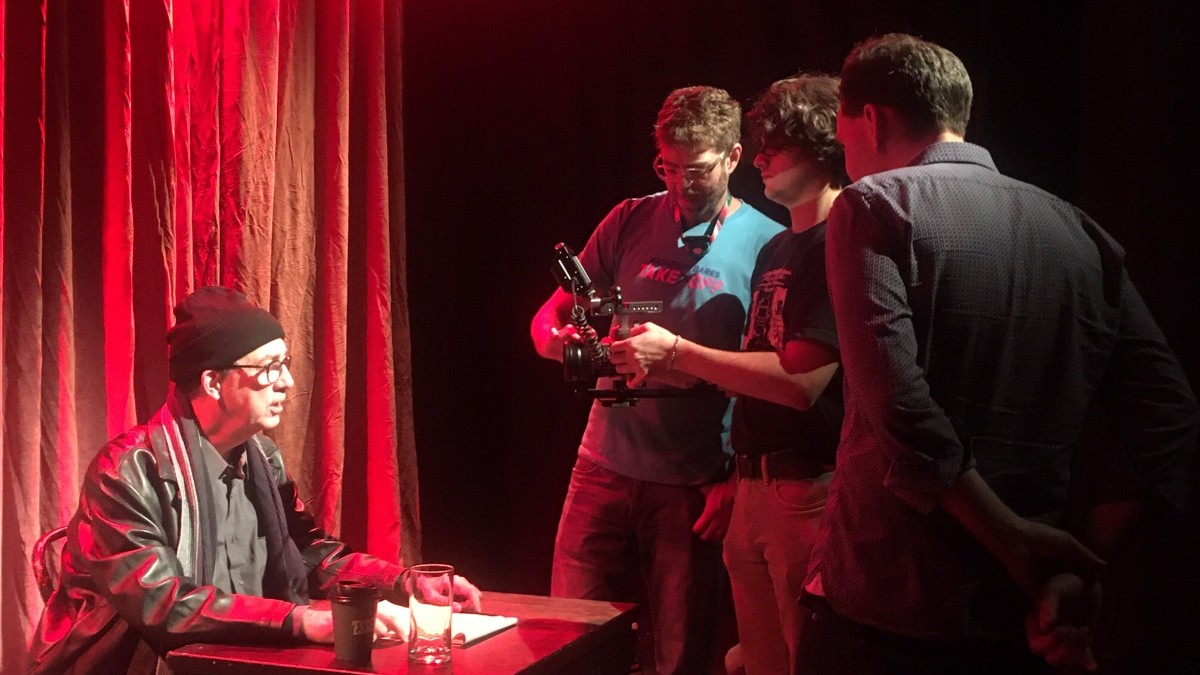
During the film production, what scene (that made the cut) was the hardest to shoot? And why?
Jocelyn Kuritsky (JK): Oof. I think they were all hard to shoot — for different reasons! We were coordinating so many things simultaneously, always behind schedule. I guess… the mirror room scene. Nic Benacerraf constructed a ‘mirror room,’ which was John Sleight’s (Tony Torn’s) art installation. Jan Leslie Harding and I spent many hours on the floor, inside the mirror room, as the crew figured out how to g t us in and out of it, and exactly how to shoot it (so many particular and odd angles). It’s a gorgeously shot scene.
What worked better in this latest production that mightn’t have worked so well in the last one you did?
Jocelyn Kuritsky (JK): Hard to compare. This was an extremely ambitious production. That said, one thing I really loved w how much we actually used the space of The Tank. I don’t know that The Tank’s space would h ve been right for all our past films, but I think we should use it for all our films moving forward. TBD.
You must have donned several hats on this film, the measure of your input required intellect, effort, tenacity, skill (…you know better). What did it take you to put out all these qualities to get the film done?
JK: Haha. Magic. True grit. The projects I make are always some combo of intense focus, organization, passion, blind faith, and serious instinct. The more I go along the more I do try to trust my instincts. I’m also increasingly fearless. I’d rather make a mistake than not make it.
What about independent filmmaking and the business do you still struggle with?
JK: All of it. Everything from ideation to production to pushing the product out is a struggle, but one I enjoy. There’s always an element of re-inventing the wheel if you are doing it right.
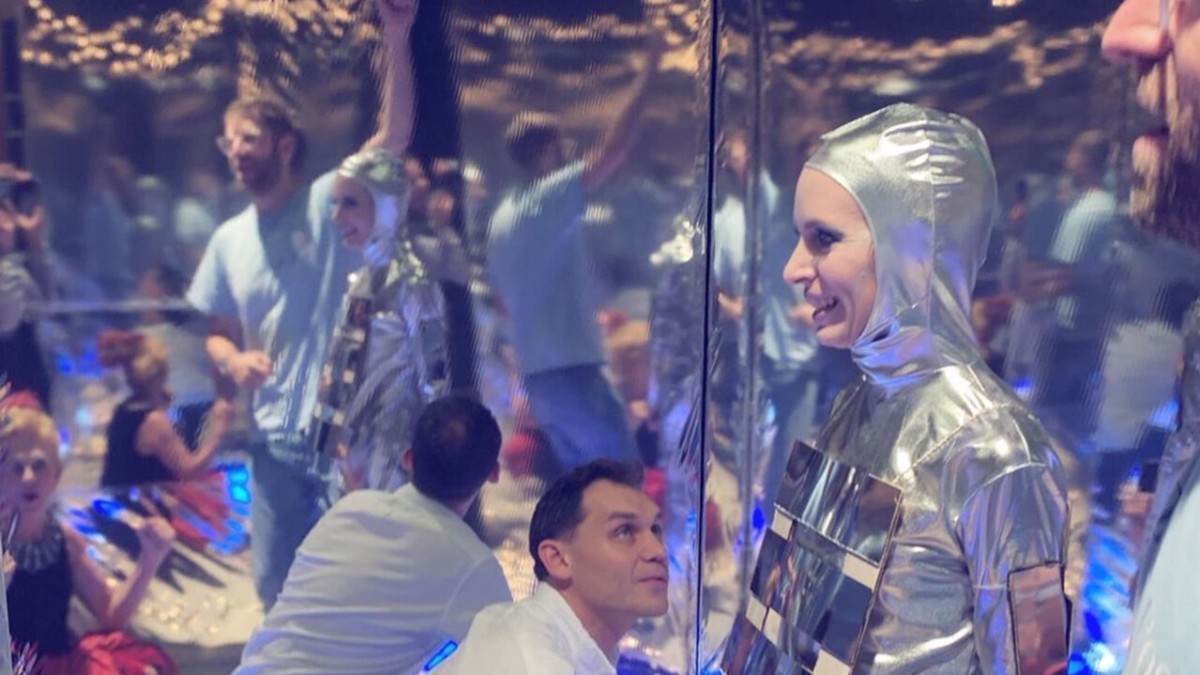
Where do you think your strengths lie as a producer?
JK: I’m really charming (and humble!;). My real strengths are that I work very hard and I’m tenacious, and I try to do what I say I’m going to do.
Let’s talk finance, How did you finance the film?
JK: I’m still financing it. The onset of the pandemic made things more complicated. We were just winding down the post on the film as Covid hit. But, generally, to finance – I asked people to give me money. I literally called people and asked; some had given to Staging Film in the past. I was pretty successful. I have less and less of a problem doing this. Money is good and necessary to make innovative art and I believe in the work I do. I also bring my donors into the fold (they’re an essential part of the project), and money does not just appear – you must be vulnerable and ask for it. That said, our culture of shame around fundraising is a tough one, and it’s an ongoing fight.
How much did you go over budget? How did you manage it?
JK: I’m not going to go into too many specifics here, but we all pulled dollars from our own pockets when we went over.
How important is marketing? Do you think a project can make a dent without it nowadays?
JK: I think this really depends on the reach you want your project to have and what you consider a ‘dent.’ I think social media and word of mouth can have enormous impact, more impact than many realize. I also think a good press rep can help shed light on a project in significant ways.
What do you hope audiences will get from the presentation of your film?
JK: I hope that people watch this film and go What is this?! Really, that’s what I hope. I hope some kid, maybe outside of New York, sees this and thinks, “Who is Mac Wellman?” “Who is Greig Sargeant?” “Who is Katja Andreiev?” And then I hope they find out.
What else have you got in the works?
JK: I’m working on a podcast project (that’s been in the works for years) about all the women who have run for President of the United States.
Tell us what you think of the interview with Jocelyn Kuritsky. What do you think of it? What ideas did you get? Do you have any suggestions? Or did it help you? Let’s have your comments below and/or on Facebook or Instagram! Or join me on Twitter.
Follow Jocelyn Kuritsky on Social Media
Website
IMDb
LinkedIn
Instagram
MORE STORIES FOR YOU
The Key Facts Behind How Jeff Nichols Made The Indie Hit MUD
Jeff Nichols gives himself directorial challenges to master on every project.
In Conversation with Michael Oblowitz Director of Confidential Informant
Confidential Informant stars Mel Gibson, Dominic Purcell, and Kate Bosworth

